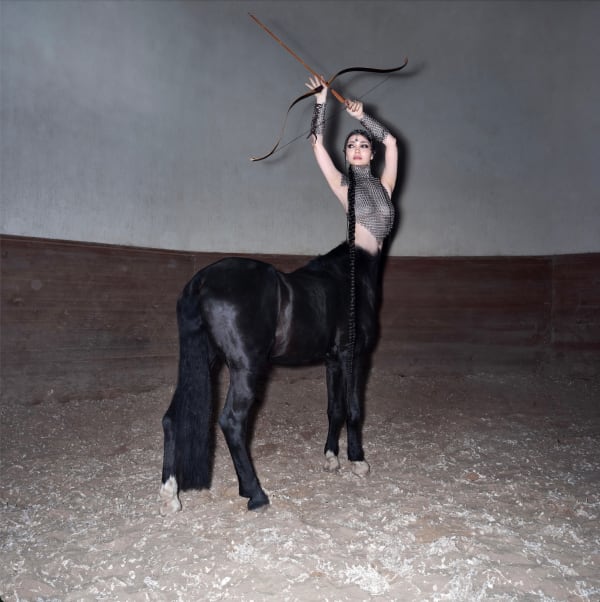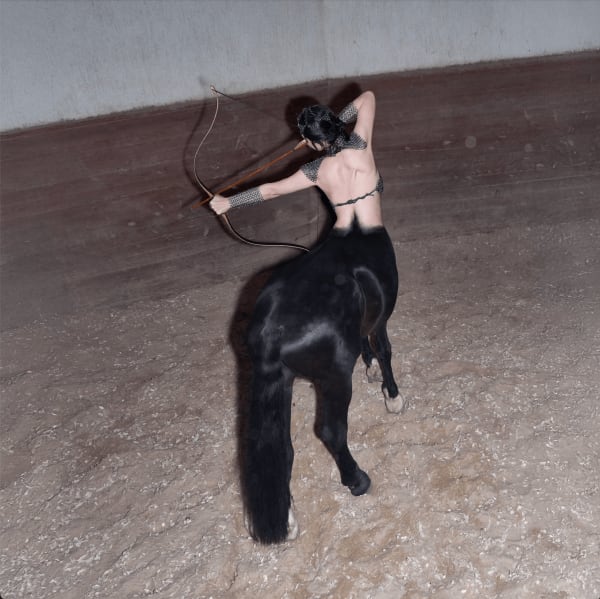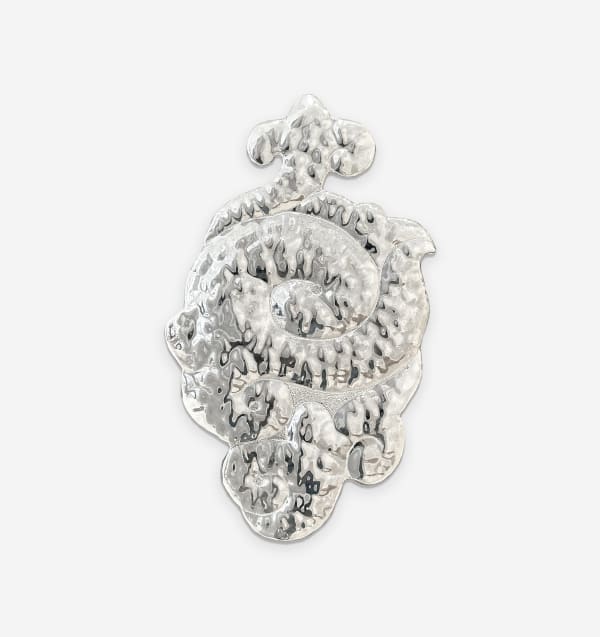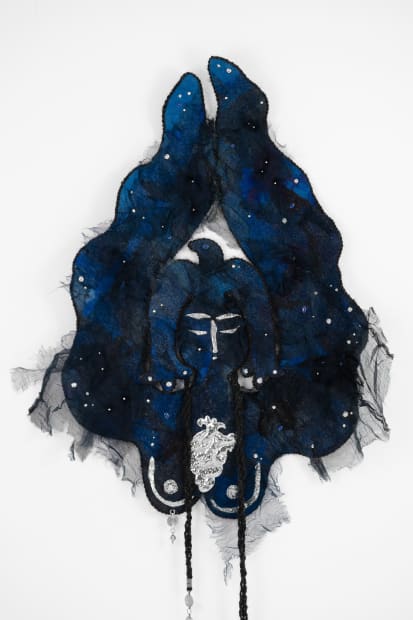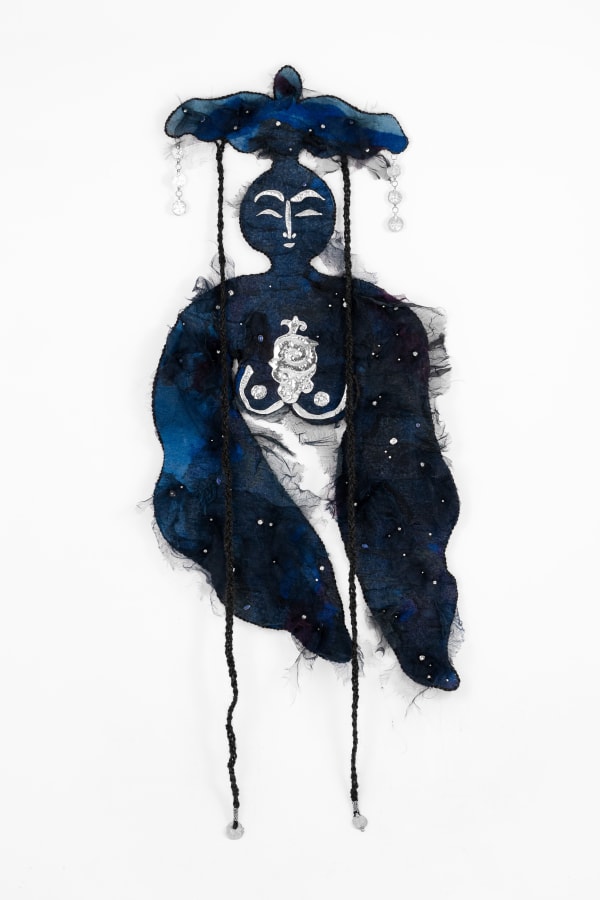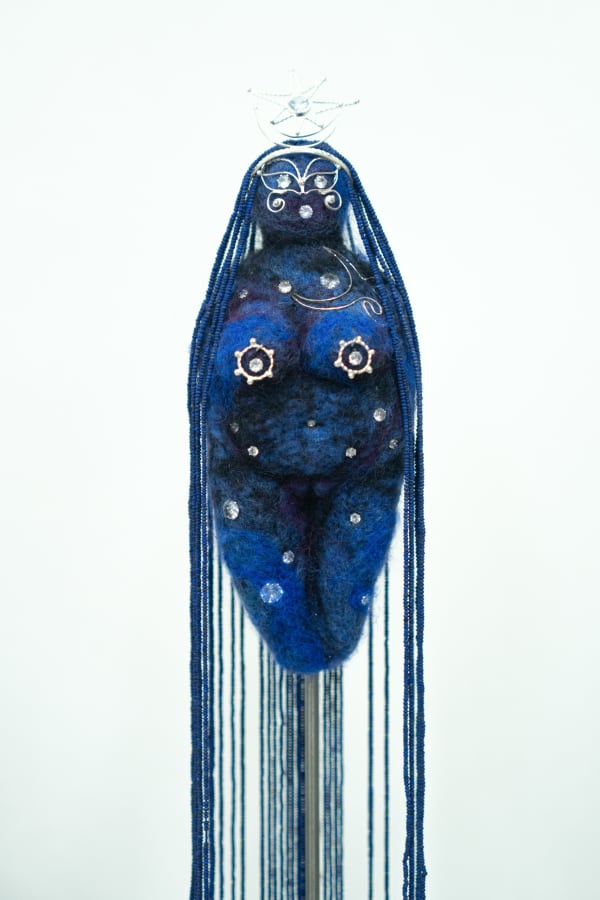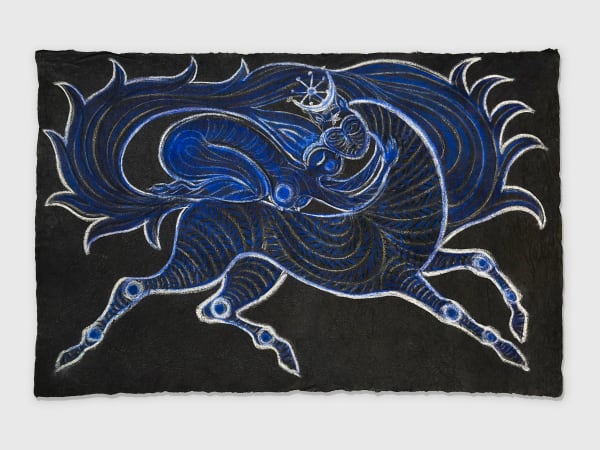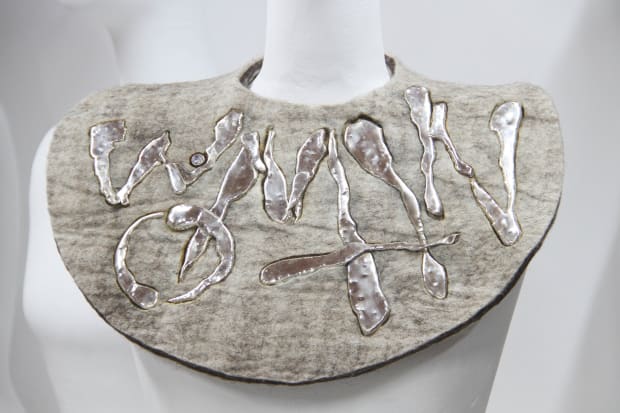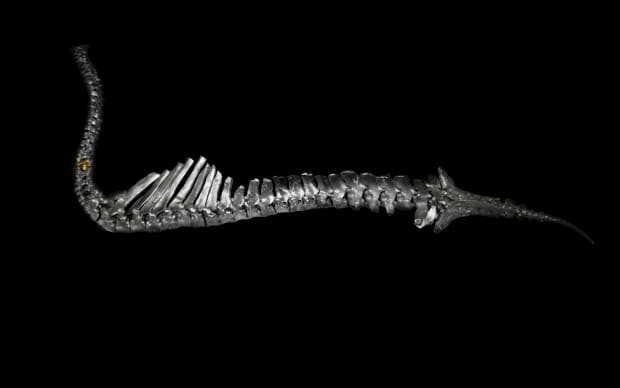-
Essay by Rachel Parikh, Ph.D., The Marguerite S. Hoffman and Thomas W. Lentz Curator of Islamic Art, Dallas Museum of Art and Deputy Director, Dunhuang Foundation
-
-

Photo Credit: Baurzhan Bismildin, Stylist & Creative Directors of the shoot are Goar Igitian & Assemgul Kulmagambetova
-

Photo Credit: Baurzhan Bismildin, Stylist & Creative Directors of the shoot are Goar Igitian & Assemgul Kulmagambetova
-

Photo Credit: Baurzhan Bismildin, Stylist & Creative Directors of the shoot are Goar Igitian & Assemgul Kulmagambetova
-
-
Altynai Osmo (Kyrgyzstan, b. 1988) and Aya Shalkar (Kazakhstan, b. 1996) explore themes of identity, feminine power, and gender roles, drawing on real and mythological narratives deeply rooted in their Central Asian cultures and heritage. Their works, across diverse media and artistic techniques, honor tradition and legacy while capturing the multifaceted and complex roles women play in Central Asian societies—from their positions within tribes to their divine manifestations. Osmo and Shalkar place the female experience at the intersection of history, mythology, tradition, and spirituality, illuminating narratives that have long been overshadowed. This exhibition, entitled, Beneath the Earth and Above the Clouds, showcases new bodies of art from both artists. Through three- and two-dimensional works, Osmo and Shalkar offer an anthropological perspective on Central Asian female identity across earthly, divine, and spiritual realms. While women of this region were shaped by culture and tradition— and are often seemingly bound by these roots— the artists also reveal how women have challenged and transcended conventional roles. Their works juxtapose tradition and transformation, where myth, history, and spirituality converge with the ongoing struggles and triumphs of women in Central Asia.
-
Osmo explores these themes through multiple series in the exhibition. In her Kyrk Kyz series, she presents four, two-dimensional spiritual masks that represent the legendary Kyrk Kyz (“Forty Girls” or “Forty Maidens”), a group of warrior women who fiercely protected their ancestral lands near Samarkand (in modern-day Uzbekistan) from invaders. The series highlights their formidable place within Kyrgyz culture, blending lore and history to symbolize feminine strength, courage, and independence. Interestingly, some theorize that the very name “Kyrgyz” may have originated from “Kyr Kyz”, directly linking the nation’s identity to the legendary sisterhood of warrior women. This etymological connection is particularly compelling within the context of a traditionally patriarchal society—suggesting that at the heart of Kyrgyz heritage lies a foundation of female strength, leadership, and resilience. Through her work, Osmo demonstrates that, despite the dominance of male-centric narratives in history, the enduring legacy of the Kyrk Kyz challenges conventional notions of power, embedding the spirit of these formidable women within the cultural fabric of Kyrgyzstan itself. The masks are meticulously crafted from felt, a material deeply rooted in Kyrgyz nomadic culture. The heroines’ features are drawn and adorned with cupro-nickel, which has been burned and fused into the felt, along with zircon accents.
-
-
 Altynai Osmo (Kyrgyzstan)Umai Oimo Jurök II (Heart like a bird ), 2025Sterling silver on burnt cotton, nuno felt and raw silk lining.6 1/4 x 4 in
Altynai Osmo (Kyrgyzstan)Umai Oimo Jurök II (Heart like a bird ), 2025Sterling silver on burnt cotton, nuno felt and raw silk lining.6 1/4 x 4 in
16 x 10 cm -
 Altynai Osmo (Kyrgyzstan)Umai Oimo Jurök III (Great Mother's Heart / Primordial), 2025Sterling silver on burnt cotton, nuno felt and raw silk lining9 7/8 x 5 1/2 in
Altynai Osmo (Kyrgyzstan)Umai Oimo Jurök III (Great Mother's Heart / Primordial), 2025Sterling silver on burnt cotton, nuno felt and raw silk lining9 7/8 x 5 1/2 in
25 x 14 cm -
 Altynai Osmo (Kyrgyzstan)Umai Oimo Jurök I (Mother's Heart), 2025Sterling silver on burnt cotton, nuno felt and raw silk lining.5 1/8 x 3 1/8 in
Altynai Osmo (Kyrgyzstan)Umai Oimo Jurök I (Mother's Heart), 2025Sterling silver on burnt cotton, nuno felt and raw silk lining.5 1/8 x 3 1/8 in
13 x 8 cm
-
-

-
-
 Altynai Osmo (Kyrgyzstan)Umai Ene II (Mother Umai)Cupro nickel on nuno felt, organza silk, lapis lazulis, zircon,
Altynai Osmo (Kyrgyzstan)Umai Ene II (Mother Umai)Cupro nickel on nuno felt, organza silk, lapis lazulis, zircon,
vintage silver details and yak hair ropes.72 x 43 1/4 in
182.9 x 110 cm -
 Altynai Osmo (Kyrgyzstan)Umai Ene III (Mother Umai), 2025Cupro nickel on nuno felt, organza silk, lapis lazulis, zircon,
Altynai Osmo (Kyrgyzstan)Umai Ene III (Mother Umai), 2025Cupro nickel on nuno felt, organza silk, lapis lazulis, zircon,
vintage silver details and yak hair ropes.63 3/4 x 25 5/8 in
162 x 65 cm
-
-
-
 Altynai Osmo (Kyrgyzstan)Venus Jengeler I (Venus Auntie with Pearl Braids)Sterling silver on felt, zircon, river pearls, stainless steel radio
Altynai Osmo (Kyrgyzstan)Venus Jengeler I (Venus Auntie with Pearl Braids)Sterling silver on felt, zircon, river pearls, stainless steel radio
antenna and white marble base stand.5 x 2 7/8 in
12.7 x 7.4 cm -
 Altynai Osmo (Kyrgyzstan)Venus Jengeler III (Venus Auntie Cloud Blue)Sterling silver on felt, turquoise, stainless steel radio
Altynai Osmo (Kyrgyzstan)Venus Jengeler III (Venus Auntie Cloud Blue)Sterling silver on felt, turquoise, stainless steel radio
antenna and white marble base stand.8 1/4 x 3 7/8 in
20.8 x 9.9 cm -
 Altynai Osmo (Kyrgyzstan)Venus Jengeler II (Venus Auntie Starry Sky), 2025Sterling silver on felt, turquoise, stainless steel radio
Altynai Osmo (Kyrgyzstan)Venus Jengeler II (Venus Auntie Starry Sky), 2025Sterling silver on felt, turquoise, stainless steel radio
antenna and white marble base stand.8 1/4 x 3 7/8 in
20.8 x 9.9 cm
-
-

-

-
Shalkar also explores these themes of female identity, power, and resilience through The World of Peri, her conceptual feminist-fantasy universe. Inspired by the history of the nomadic Turkic tribes of the Eurasian steppes, it imagines an alternate past in which women held absolute power. The World of Peri is a powerful response to Kazakhstan’s deeply patriarchal society and its systemic oppression of women. Shalkar invites audiences to explore The World of Peri through what she calls a “future archaeology” approach. In her work, Mergen, meaning “skilled archer” in Kazah, Shalkar reconstructs the burial site of Mergen, a female centaur warrior unearthed in Kazakhstan. Mergen tells the story and the mythology of the powerful Peri civilization through crafted, “discovered” artifacts.
-

-
Surrounding the remains are objects that once belonged to the female warrior – a hunting knife, a hair comb, a belt, a set of arrowheads, an archer’s ring, a preserved centaur’s braided tail, and a set of “horseshoes”, all of which reflect the dualities between beauty and ferocity; softness and strength; and individual and ancestral identity.
-
About the Artists
Altynai Osmo (b. 1988) is a multimedia artist based in Kyrgyzstan and is a graduate of Central Saint Martins College of Art and Design in London, United Kingdom. Altynai works across various mediums such as graphics, textiles, artwear, jewelry, photography, video, installations and sculptures. The artist draws inspiration from the philosophy, aesthetics and an abundance of her Central Asian nomadic culture. Currently, she is focusing on creating images of free spirited women of Central Asia, defying the difficult socio-political situation and growing gender based violence in Kyrgyzstan. Further, she explores intergenerational connections, especially on the maternal side, the relationships between matriarchy and ancestors and familial bonds' affecting a woman's identity. Altynai's work actively explores the intersection of traditional and contemporary societies and cultural norms, delving into the clash between the two.
Through her art, Altynai aims to provoke thoughtful reflection, challenge preconceptions, and foster a dialogue that contributes to positive social change. In essence, Altynai Osmoeva's artistic practice strives to be a catalyst for societal awareness and transformation, promoting empowerment, resilience, and a reevaluation of cultural and gender dynamics in the Central Asian region and beyond. Having engaged in numerous international exhibitions, Altynai has been the recipient of prestigious awards, including recognitions like Vogue Young Talents (Italy, 2014), International Contemporary Crafts Biennale (China, 2014), Saga Furs (Netherlands, 2013, 2015), Creative Spark (UK, 2020, 2021), Felt, Fat and Fictions / Joseph Beuys at Goethe Institute Tokyo (Japan, 2021), Soros Foundation Stipend in Art (Kyrgyzstan, 2020, 2023), Arte Laguna Prize (Italy, 2023), Berlin x Bishkek Art Weeks (Germany, 2023), Larking Dawn fellow at Art Omi (USA, 2023), X Mediations Biennale at ArtIstanbul Feshane (Turkey, 2023) and multiple UNESCO Award of Excellence Certificates. Altynai Osmoeva is a member of the World Crafts Council, ArtCity e.V. and the Artists Union of the Kyrgyz Republic. She also participated in the 15th Havana Biennial/AkJol-Open Roads film-Art Director, Cuba; Chrome47, ArtCity e.V., Germany; CEC ArtsLink International Fellowship 2025; Her Art in Action, Var Yox at Gazelli Art House, Baku, Azerbaijan; Yurt Now! Nomadic design relieved at MARKK Museum am Rothenbaum, Germany. Her work is part of the Brown University Collection (Providence, RI).
Aya Shalkar (b. 1996) is a Kazakh conceptual multimedia artist currently based in Los Angeles. At the age of 17, she moved to France to study Visual Arts at the University of Strasbourg. She later transferred to the University of Applied Arts Vienna, Austria, where she received Masters in Graphic Design in 2020. Shalkar is the co-founder of Studio Oneki, an experimental design studio based in Kazakhstan. Shalkar’s artistic practice is rooted in her Central Asian background and Kazakh visual and material culture, with many of her works addressing cultural identity and gender roles. Her artistic universe, The World of Peri, merges indigenous Kazakh culture with elements of science fiction and fantasy, reclaiming the underrepresented female warrior archetype. A traditional Kazakh-style archer, Shalkar does not just depict her warrior characters—she embodies them. Her practice is deeply immersive, bridging artistic creation with lived experience. Shalkar’s creative approach, which she describes as future archaeology, combines artistic practice with historically accurate research on ancient Turkic culture. Beyond textile techniques such as embroidery and patchwork that are predominantly practiced by women, she delves into artifact reconstruction, reimagining lost relics of the nomadic past through the lens of a speculative, magical world. By recreating weapons, adornments, and ceremonial objects, she breathes new life into traditions that have been overlooked or forgotten. Shalkar’s vision is influenced by her graphic design training and passion for sci-fi. Her artistic universe is a place where Central Asian heritage meets science fiction and fantasy. Further, Shalkar pulls from her modeling and acting experience in order to incorporate her own body and image into her artistic projects. Her digital work has organically found its place in Web3 as successful NFTs. Her weapon sculptures—daggers, swords, and other ritual objects—serve as both historical reconstructions and futuristic talismans, blending craftsmanship with mythmaking. Shalkar has been featured in magazines such as Nowness, i-D Magazine, Elle, Sleek, Blood, Forbes, and Harper’s Bazaar. Her work is part of the Brown University Collection (Providence, RI).
-
About Rachel Parikh, Ph.D.
Rachel Parikh, Ph.D., is the Marguerite S. Hoffman and Thomas W. Lentz Curator of Islamic Art at the Dallas Museum of Art. She also serves as Deputy Director for the Dunhuang Foundation. Dr. Parikh also held positions at the Metropolitan Museum of Art, New York; the Art Institute of Chicago; and the Harvard Art Museums. She is a specialist of South Asian and Islamic works on paper as well as arms and armor. She received her Ph.D. from the University of Cambridge. Her most recent exhibition was Might and Magnificence: Ceremonial Arms and Armour Across Cultures, held at the Indra and Harry Banga Gallery, City University, Hong Kong (November 5, 2024 – February 23, 2025).



